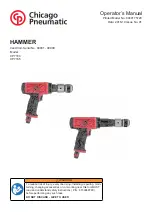
PAD-L
Applied Operation
4-9
4.2.3
Output voltage control with external voltage
This method is used to control output voltage using 0- approx. 10 V.
○
○
○
○
○
○
○
○
○
○
○
○
○
○
○
○
○
○
○
○
○
○
○
○
○
○
○
○
○
○
○
○
○
○
○
○
○
○
○
○
○
○
○
○
○
○
○
NOTE
•
When controlling the unit using an external voltage source which has a quick
rising time relative to the capacitive load, the phase control circuit of the unit
cannot respond to the external voltage, which may cause AC components to be
superimposed on the rising waveform.
○
○
○
○
○
○
○
○
○
○
○
○
○
○
○
○
○
○
○
○
○
○
○
○
○
○
○
○
○
○
○
○
○
○
○
○
○
○
○
○
○
○
○
○
○
○
○
Connecting procedure
1.
Turn off the POWER switch.
2.
As shown in Fig. 4-6, remove the shorting bar across the control
terminals 5 and 6.
3.
Connect an external source (Ei) across the control terminal 6 and +S
terminal as shown in Fig. 4-6.
WARNING
•
Isolate the external voltage source (Ei) and the cable connected to
it with at least the isolation voltage of the unit. Float Ei outputs
instead of grounding them (floating). For details, see 2.6
"Grounding the output terminal."
•
When using a shielded cable for the connection, protect the
uncovered part of the cable with an insulation tube of at least the
isolation voltage of the unit.
CAUTION
•
Watch the polarity of Ei. Connection at incorrect polarity may
damage the unit.
•
If Ei is disconnected, an unexpected voltage may be supplied by
external noise. To assure a good connection, use crimped
terminals.
•
Do not apply a voltage of 11 V or more, or reverse the voltage
between control terminal 6 and +S terminal. Otherwise, the unit
may be damaged.
○
○
○
○
○
○
○
○
○
○
○
○
○
○
○
○
○
○
○
○
○
○
○
○
○
○
○
○
○
○
○
○
○
○
○
○
○
○
○
○
○
○
○
○
○
○
○
NOTE
•
To reduce the effects of noise on output, use a 2-core shielded wire or a
twisted-pair wire to connect to terminals, making them as short as possible.
Longer wiring results in greater susceptibility to the effects of noise, and use of
cables with antinoise measures may not solve the problem, resulting in
improper operation.
When using a shielded wire, connect the shield to the + (pos.) output terminal.
•
The input impedance across the control terminal 6 and the +S terminal is 3-10
k
Ω
.
Summary of Contents for PAD-L III Series
Page 4: ...II PAD L...
Page 16: ...P 6 Preface PAD L...
Page 40: ...2 12 Precautions and Preparations for Use PAD L...
Page 86: ...4 34 Applied Operation PAD L...
Page 98: ...5 12 Names and Functions of Controls PAD L...
Page 130: ...7 14 Specifications PAD L...
















































